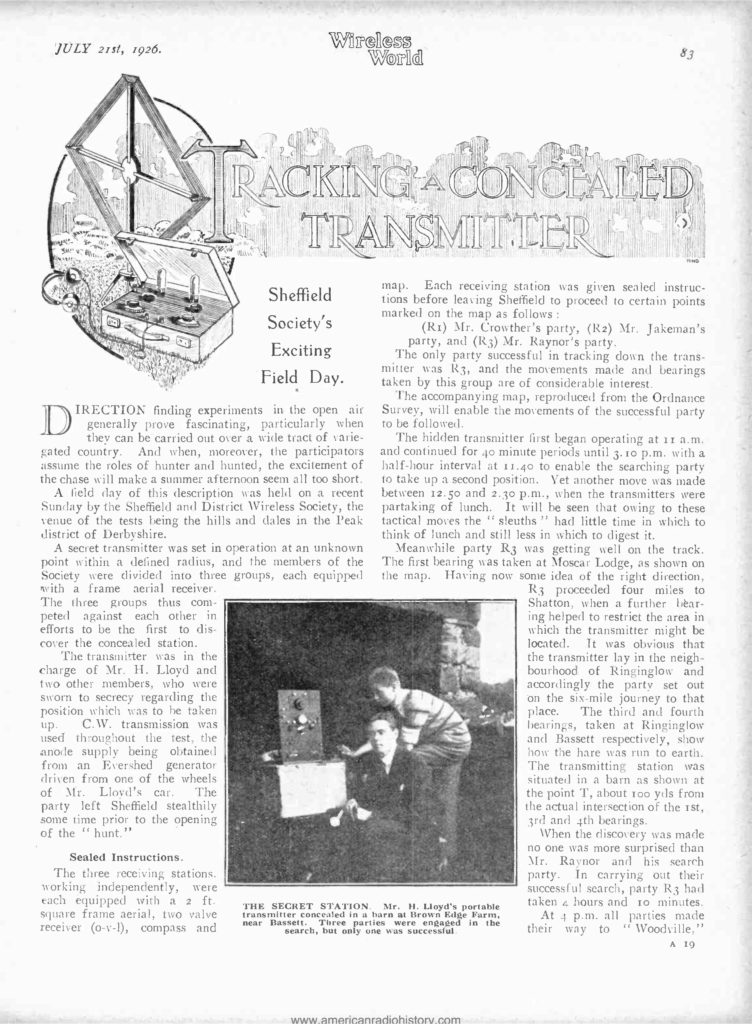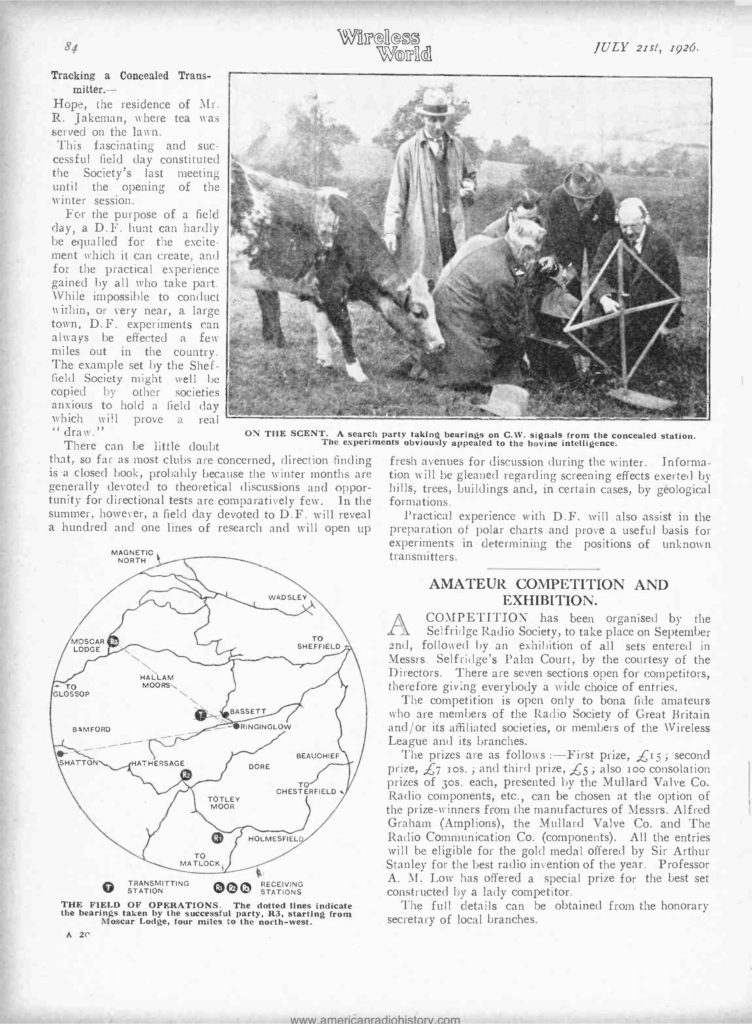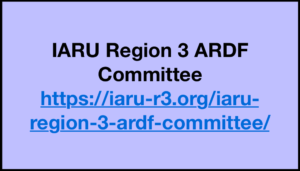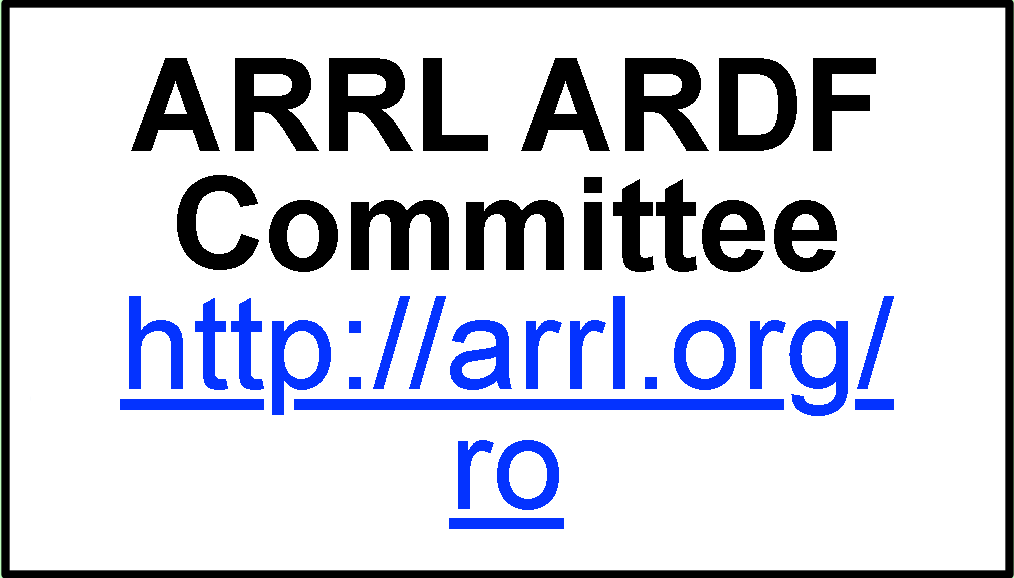The following account of a 1926 “Field Day” foxhunt makes for interesting reading. It had three hunters, one fox, and zero transistors. All the radio equipment was made with vacuum tubes (valves). The story is from Wireless World’s July 21, 1926, page 83-84. PDF versions of Wireless World can be found at https://worldradiohistory.com/Wireless_World_Magazine.htm
Author: Radio-O
2023 Radio Orienteering Hierarchy
This is an update to a blog entry originally posted in July 2018.
Below is a diagram depicting the current way that ARDF is administered with a focus on Region 2. The diagram shows all the entities responsible for how ARDF is defined, practiced, and promoted in IARU Region 2. The lines between the various entities imply the type of relationship or interaction between them.
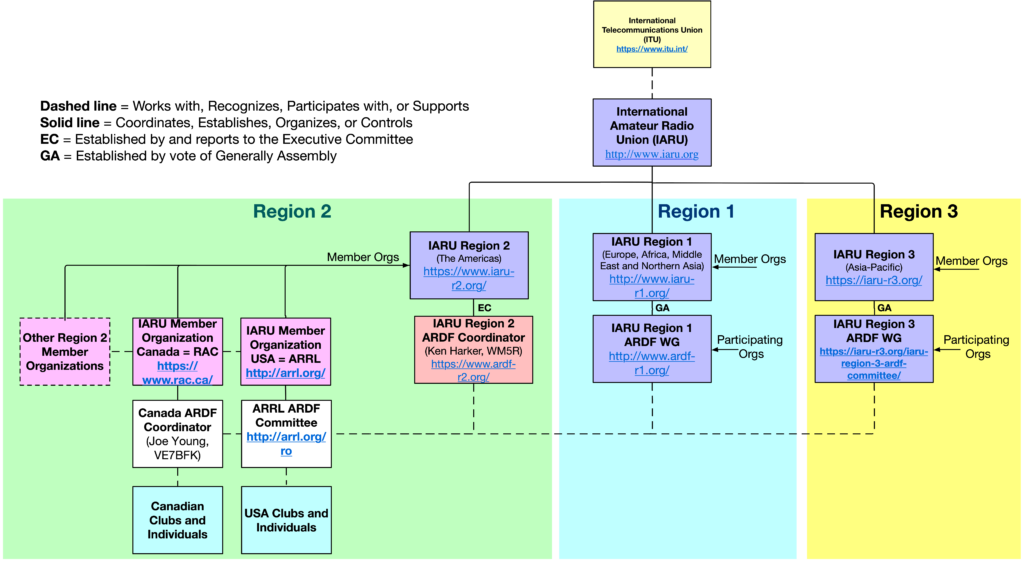
The intent of the diagram is to depict the current ARDF-related entities and their relationships to one another diagrammatically. Their roles and responsibilities are discussed below.
ITU & IARU
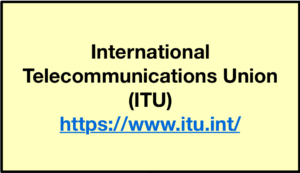
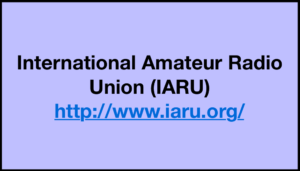
If we focus on the sport of ARDF, the ITU and the top level of the IARU have no direct influence on the sport. Radio sports are not specifically mentioned in their constitutions or bylaws and are not managed at that level. The ITU and IARU are included in the diagram only to complete the “big picture.”
IARU Regions
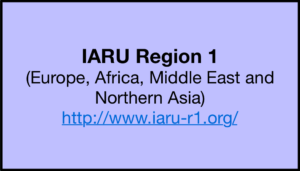
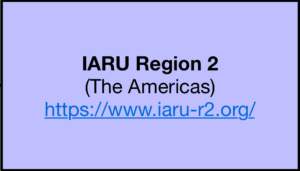
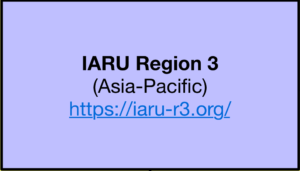
IARU Regions are autonomous and operate in accordance with their own Constitutions. Their members are comprised of national societies representing each region’s member countries. See ARRL IARU.
The IARU regional organizations are at the top of the ARDF hierarchy, in that they have responsibility for defining, supporting, and managing the sport. Having three autonomous organizations all managing ARDF from the top could lead to divergence in how the sport is played and organized around the world. Such divergence could be beneficial by allowing the regions to customize ARDF to maximize interest among their member societies. But too much divergence would be detrimental if it were to result in three separate incompatible sports. Fortunately, the regions have insisted on making inter-regional coordination a priority.
IARU regional organizations are not obligated to recognize ARDF at all. The autonomous regions are free to address the needs of their regional membership as appropriate to fulfill their missions. If ARDF plays an insignificant role in a particular region, and the member societies consider it unimportant, a region need not support it at all. That was the case in IARU Region 2 until the year 2001.
In September 2001 IARU Region 2 approved Standard Operating Procedures (SOP) that recognized the sport of ARDF in the region:
ARDF, the activity. Amateur Radio Direction Finding is a technical, sport activity within the framework of the amateur radio service. It deals with the taking of radio bearings and finding hidden transmitters, constructing direction-finding equipment, and the training of amateurs involved in and with the organizing of relevant sport and social events.
IARU Region 2 ARDF Coordinator
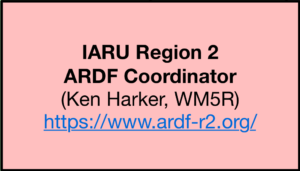
In the same September 2001 Standard Operating Procedures, IARU Region 2 defined a new role: IARU Region 2 ARDF Coordinator. That role was created as a “special advisory committee” by the Executive Committee (EC) and reports directly to the EC.
The first person appointed to the new position was Dale Hunt, WB6BYU, who held the position until August 2018, when he retired. Replacing him was Kenneth Harker, WM5R, who currently holds the position.
The Region 2 ARDF Coordinator was assigned duties related to investigating the popularity of the sport in the region, keeping track of ARDF activities in the other regions, and reporting back to the Executive Committee with findings and recommendations:
ARDF Coordinator Duties.
(a) The Region 2 ARDF Coordinator shall become aware of, and shall encourage and support, ARDF activities within Region 2 and shall report on such activities from time to time to the Region 2 Executive Committee.
(b) The Region 2 ARDF Coordinator shall, in general, be aware of ARDF activities in IARU regions 1 and 3 and shall report on such activities from time to time to the Region 2 Executive Committee. The Region 2 ARDF Coordinator shall also cooperate with the ARDF coordinators from Regions 1 and 3 for the purpose of promoting ARDF activities worldwide.
(c) The Region 2 ARDF Coordinator shall make any such recommendations as are reasonably necessary and appropriate to the Region 2 Executive Committee to promote ARDF activities within Region 2.
ARDF Working Group

The creation of an IARU Region 2 ARDF Coordinator position was a significant step forward, but still left ARDF’s stature in Region 2 in a very different state from other regions. IARU Regions 1 and 3, where ARDF is more established and widespread, have established ARDF working groups by resolutions passed by the Member Societies at regional General Assemblies (GA).
The responsibilities of those groups are described by IARU Region 1 ARDF Working Group to include:
1. To disseminate information related to ARDF.
2. To develop ARDF materials and answer questions from other IARU bodies.
3. To provide ARDF advice and help to IARU Member Societies, to prepare bulletins and educational material, to assist the IARU Regional Member Societies in ARDF activities.
4. To submit ARDF advice, proposals, and recommendations to the Executive Committee.
5. To participate in the organization of IARU ARDF events.
6. To undertake ARDF activities on behalf of the IARU Region.
7. To organize IARU international events and championships.
8. To support sport and technical progress in ARDF.
9. To prepare the ARDF competition rules.
10. To provide for skilled referees serving at International, Regional and World Championships.
11. To cooperate with similar bodies in other IARU regions that promote and administer the sport, helping promulgate and standardize the sport throughout the regions, and coordinating ARDF activities between the regions.
The disparity between Region 2 and the other regions regarding their support for ARDF remains. Unless the Region 2 Organization can be persuaded otherwise, this situation might not change so long as the sport is isolated to only a few Region 2 countries.
Without an entity tasked with administering the sport at the regional level, the responsibilities above are not officially supported by Region 2. Instead, ARDF coordination and administrative responsibilities fall to the member societies and individuals, where they are addressed on an ad hoc basis if they are addressed at all.
The creation of a Permanent ARDF Working Group for Region 2 would require the passage of establishment legislation (a resolution) at a Region 2 General Assembly. Region 2 General Assemblies are triennial events, with the next one scheduled to occur in 2025 in Ecuador and will be hosted by the Guayaquil Radio Club. A resolution to create a Region 2 ARDF Working Group would need to be sponsored by one or more Region 2 Member Societies.
IARU Member Organizations (Member Societies)
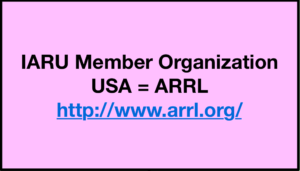
The members of the IARU Regional organizations are those societies of radio amateurs situated within Region 2 that are members of the International Amateur Radio Union. The IARU Constitution states that there shall be only one Member-Society representing a country or separate territory.
Radio Amateurs of Canada (RAC) is the member organization representing Canada.
The American Radio Relay League (ARRL) is the member organization representing the USA. The ARRL is a member of IARU Region 3 as well as Region 2 because it represents the radio amateurs of Guam, the Northern Marianas and American Samoa which are located in Region 3.
In Regions 1 and 3 where ARDF is the responsibility of working groups comprised of representatives appointed by member societies, those member societies retain at least the following ARDF-related responsibilities:
1. Maintain their full membership in a regional IARU organization.
2. Assign a society representative to the ARDF Permanent Working Committee or Working Group.
3. Delegate single competitors or teams to participate in intra-regional competitions.
4. When authorized by its corresponding IARU regional organization it may organize a World Championship.
5. When authorized by its corresponding IARU regional organization it may organize a Regional Championship. A Regional ARDF Championship is the event to award the title of Regional Champion in ARDF.
In Region 2, there are no specific ARDF responsibilities nor authority assigned to the member societies. So the ARRL is able to exercise the authority afforded by other regions to member societies from outside those regions. Within the borders of the USA, the ARRL is authorized and constrained by its own Articles of Association, Bylaws, and internal policies, and by a desire to best serve its membership and cooperate with its fellow societies within and outside Region 2.
ARRL ARDF Committee
In July 2019 the ARRL Board of Directors established the ARRL ARDF Committee. Gerald Boyd, WB8WFK and Charles Scharlau, NZØI, were appointed by ARRL President Rick Roderick, K5UR, to serve as USA ARDF Co-coordinators. Jerry and Charles recruited and nominated a team of ARDF experts to serve on the new committee. The ARRL ARDF Committee selects the national team, works to ensure USA radio orienteering championship events are held annually and serves to promote the sport domestically.
According to its Terms of Reference, the purpose of the ARRL ARDF Committee is: “to fulfill, in the name of the ARRL, those responsibilities assigned to IARU member societies that participate in Amateur Radio Direction Finding as administered by the IARU regional organizations. Those responsibilities include assigning a society representative to represent the League in an IARU regional ARDF administrative committee or working group, and delegating single competitors or teams to participate in international competitions. When authorized by its corresponding IARU regional organization a member society may organize a World or Regional Championship.”
Local Organizations and Individuals
The folks participating in ARDF activities, and the clubs and groups that directly support them, are the grassroots of the sport. Collectively, they hold ultimate control over the sport, for without them there would be no ARDF activity to manage.
Though their number remains relatively small, ARDF enthusiasts in Region 2 include enough individual talent to fix all that ails ARDF. But it is up to the grassroots to insist on leadership and organization that will utilize that talent to make ARDF prosper.
If you can help complete or correct the information presented above, please let me know. Although I’ve attempted to make it accurate, it might contain errors or omissions. Please let me know if you are aware of changes that should be made, or if you have suggestions for making it more clear and understandable.
Fun With ‘Phones
They’re an essential part of a radio orienteer’s equipment. Without them, your receiver would be worthless. Some prefer headphones, others earphones. But whichever you choose, you want them to be comfortable and secure and to deliver ample sound to your ears.
It is true that, in a pinch, just about anything that delivers sound waves to your eardrums will get the job done. But high-fidelity audio has its benefits. It allows knowledgeable radio orienteers to discern perturbations in the received signal that distinguish reflected signals from the direct signal or to accurately gauge a subtle climb in signal strength confirming progress made toward the fox. So your choice of earpiece can make a difference. Here are some things to consider when selecting your radio-orienteering ear gear.
Once upon a time, it was easy to find single-ear and monaural 2-ear devices. These are almost nonexistent today, so they will not be discussed here. Only stereo 2-ear devices are considered. Almost as long ago, high-impedance headphones and earphones were widely available and would be incompatible with most radio orienteering receivers built in the past 20 years. That’s something to be aware of if you scrounge the junk box for old earpieces. Most new earphones and headphones are ~32Ω impedance, and most radio orienteering receivers sold today are designed to work with them. So don’t be too concerned about impedance unless you are dealing with older or homebuilt equipment.
High-end headphones and earphones may not be what you’ll want to wear while running through the woods in all kinds of weather. Although high-end earpieces should work very well for radio orienteering, and come with lists of cool features commensurate with their price tags, you are unlikely to find waterproof listed among their features. And Bluetooth connectivity, if required, will likely entail adding a Bluetooth transmitter (covered below) to your receiver to make it compatible. Noise cancelation would be a nice feature to have, and a pass-through mode for holding conversations would be sweet. But along with such features comes the need for the headset to have its own battery, which must be kept charged. In the end, most of us will find simple wired headphones and earphones work just dandy for this sport.
Headphones or earphones? Headphones are worn entirely outside your ear. Earphones go just inside your ear. Both are suitable for radio orienteering. Let’s explore them.
Headphones
Headphones come in two types: over-the-ear and on-the-ear. As their name suggests, over-the-ear headphones feature ear cups that entirely surround the ear and have padding that rests against the side of the head.

On-the-ear headphones have smaller ear cups with padding that rests on top of the ear. Both over-the-ear and on-the-ear use a headband of some sort to hold the ear cups securely over both ears. Over-the-ear has two significant advantages over on-the-ear headphones: 1) they more effectively seal out ambient noise that might distract from the received signal, and 2) they can fit more securely on the head and are not as susceptible to being dislodged by the vibrations of running and jumping. But on-the-ear headphones have the advantage when it comes to price and weight.
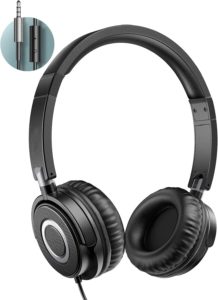
Earphones
Earphones also come in two varieties: those that rest just within the ear canal and those that rest on the concha just outside the ear canal. Naming conventions vary, but the latter are sometimes referred to as “earbuds,” so we’ll use that term too. The former we’ll call “in-canal earphones.”

In-canal earphones feature rubbery or spongy cushions that rest against the walls of the ear canal, helping to seal out external noises much as over-the-ear headphones do. And the cushion within the ear canal can also help keep them from slipping out during a competition. But some earbuds, particularly those designed to be worn during exercise, include a headband or behind-the-ear hook that holds them in place better than in-canal earphones lacking that feature. If you have some earphones you like, but they don’t stay securely in your ears, explore adding your own headband to help keep them in place.
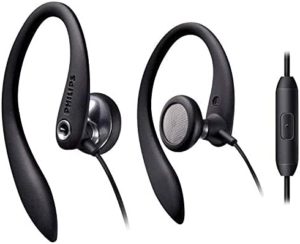
The choice of headphones or earphones is a matter of personal preference and price. Both can deliver excellent sound. Both have options that will help them stay securely attached to you. But they both have an Achilles heel: that piece of wire with a penchant for getting snagged on branches: the cord. When snagged, you’re lucky if the cord only tugs the headphones off your head. Too often, the tug will break one of the essential wires inside the cord, leaving you deaf to the foxes’ signals.
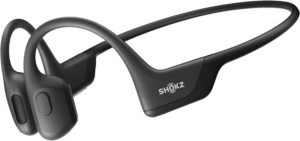
Snaking the cord carefully through your shirt sleeve can help guard it against the tugs of trees and bushes. Attaching the cord to your clothing with several safety pins can help prevent tugs from yanking on the vulnerable plug and speaker connections. But even with all the defensive measures in place, the cord remains a vulnerability. Cords wear out. They are constantly being twisted and turned, causing their delicate wires to wear and break. So always (ALWAYS!) carry a spare earphone. The spare can be a bargain basement earphone (that thing the airline gave you and you stuck in a drawer). Pin it to your jersey, or place it inside a zipped pocket. Having a spare can mean the difference between completing the race with only a minute lost, or having to orienteer your way to the finish only to receive an OT.
Bluetooth
Nowadays, the headphone cord is optional: you can opt for Bluetooth headphones or earphones. What’s that? You say your receiver does not provide Bluetooth support? There’s a fix for that: Bluetooth support can be added using a Bluetooth transmitter.
There are two very important criteria for any Bluetooth transmitter product you choose to use for radio orienteering: it must provide reliable audio to your Bluetooth earpiece, and it must have low latency. The critical need for reliable audio is obvious, but low latency is almost as important. Your transmitter and Bluetooth earpiece must work together to provide audio with very little audio delay (latency). Otherwise, there will be a discernable lag between turning the antenna and when you will hear the resulting change in signal strength. That lag can result in bearing errors.
You must run some tests to determine if reliability and latency will be acceptable. Test your Bluetooth transmitter as soon as it arrives, and hold onto any receipts in case you need to return it. Attach the Bluetooth transmitter to your radio orienteering receiver, then pair it with your earpiece. Once paired, turn off the Bluetooth transmitter and earpiece. Turn them both on again. Do they quickly find one another and re-establish the audio flow every time? Repeat this test several times. There should be no problems getting audio to both your ears within ~10 seconds of powering up. And audio should continue to flow uninterrupted for hours, without significant glitches.
To test for acceptable latency, tune your radio-orienteering receiver to a signal and adjust the audio gain to a comfortable level. Point the antenna for maximum signal strength. Then quickly turn the antenna for minimum signal strength, then back again to maximum, and repeat. The volume of the sound in your ears should closely track the motion of the antenna. If the lag slows down your ability to quickly determine the precise antenna headings for maximum and minimum, then the lag is excessive.
Note: as of this writing, the author has not discovered a Bluetooth transmitter and earpiece combination that meets the two most important criteria (reliable audio and low latency). But I’ve only tested one highly-rated transmitter and earphone combination thus far. Bluetooth technology has come a long way and continues to improve rapidly. Acceptable hardware is probably out there somewhere or soon will be. Leave comments on what your results are.
While adding a Bluetooth transmitter and headphones or earphones will eliminate cord failures, it will also add new ways for your audio to fail. But hopefully, if you keep all batteries charged, failures will be less likely than when using a cord. But going Bluetooth is not likely to remove the requirement to carry a spare (plug-in type) earphone!
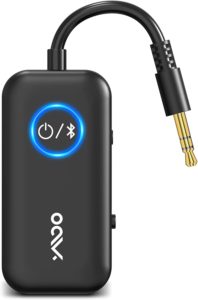
In addition to kicking the cord, going Bluetooth has another advantage: it provides more headphone options. Perhaps you already own a Bluetooth earpiece you’d like to use for radio orienteering. Bluetooth might prove to be your low-cost option in this situation – and provide some really cool features to boot.
Keep the Wet Out
Radio orienteering is played in all kinds of weather, which is a problem when it rains. Oh, you’ll muddle through and dry out with no harm done. But what about your radio equipment? Transmitters and receivers do not tolerate moisture. Water can render them temporarily inoperable or even damage them permanently. So it is imperative to keep water where it belongs: outside the equipment case.
The case surrounding the sensitive electronic innards of your equipment might look waterproof, but unless you’ve taken measures to make it so, it is a sure bet that it leaks like a sieve. Anywhere that water can seep, it will do so. That includes every hole, seam, and joint. It also includes all jacks, buttons, switches, and shafts. If it passes through the wall of the enclosure, it can leak.
So what to do? The answer: everything you can to keep water from penetrating the equipment box. There are several layers of defense. Let’s start with the outermost and work our way in.
Rainhat and Galoshes
The simplest, and least effective approach, is to keep the water from reaching the equipment. That can be accomplished by shielding the equipment with a suitable raincoat. A plastic bag can be quite effective for keeping rain from reaching a stationary transmitter. A bag is less effective for shielding a portable receiver swinging in a runner’s hand. First, the antenna elements will generally be too large to be inside, so they must penetrate the bag, resulting in holes for water to enter. Then there’s the headphone cable – creating yet another hole. Operating the receiver will require pinching knobs and switches through a layer of plastic or adding a large hole for the hand to fit through. Duct tape or electrical tape can help seal around all the punctures in the bag, but such measures might not last through a soggy race. The bottom line: bags are an unreliable method for protecting radio-orienteering receivers and should be used only as a last resort or as an extra layer of protection.
Sealing the Box
The next line of defense is the equipment case itself. Seams and gaps at panel and box interfaces can be covered by duct or electrical tape. They can also be filled using “Liquid Electrical Tape,” silicone glue, sealant, Plasti-Dip, or suitable paint.
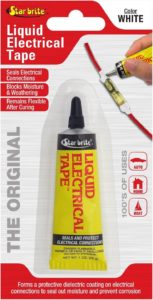
When the gap involves a removable panel providing service access (like a battery compartment cover), the filler material needs to be temporary. Silicone paste (aka waterproof dielectric grease) is perhaps the best temporary filler. It is thick and long-lasting, harmless to rubber or plastic, and remains a thick paste even at high temperatures (unlike petroleum jelly). Silicone grease can be applied to jacks, switches, and around potentiometer shafts, where it will help seal out moisture even when those items are moved, rotated, or a plug is inserted. The downside to silicone grease is that it is messy and slippery when eventually, it spreads around the case and to other objects that come into contact with it. But it cleans up readily with soap and water or some rubbing alcohol. Some formulations are toxic and can irritate the eyes and skin. Follow label directions.
![]()
Putting some silicone grease into the headphone jack will do a good job of sealing it against water. The headphones simply plug in as usual, pushing the silicone grease aside, but leaving enough of it to seal around the plug. It is just the kind of application that silicone grease is designed for. Consider keeping some silicone grease available in your equipment bag for use on wet days.
Sealing Inside the Box
Inside the receiver’s enclosure, you might be able to access the backsides of the panel-mounted components. Sometimes, the back of a jack, potentiometer, or switch can be safely and readily coated with a sealant. Care should be taken to ensure the sealant does not seep into the component and damage it. Thoroughly sealing the back of a jack, switch, or potentiometer can effectively block moisture that would otherwise leak through. While sealing inside the box will keep water from getting inside the enclosure, it does not prevent it from getting inside the sealed components. Jacks, potentiometers, and switches with inward-facing surfaces sealed, still need to be protected from the outside or be thoroughly dried and treated with contact cleaner after any exposure to water.
Once your equipment’s enclosure is thoroughly sealed, you might consider placing a small pack of desiccant inside it. The desiccant will remove moisture from the air inside the device. The resulting extremely-dry air is ideal for extending the life of electronic devices and will prevent condensation from forming on surfaces inside the enclosure when the device gets cold. The desiccant packet will need to be replaced (or recharged by heating) periodically, typically every 6 to 12 months.
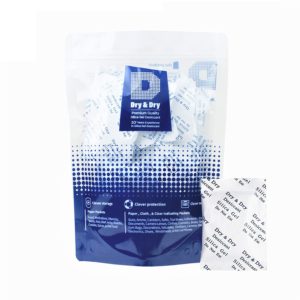
Sealing the Board
The last line of defense against water is at the board level. Printed circuit boards (PCBs) can be coated to protect them from moisture. A thorough conformal coating can render a PCB sufficiently waterproof to continue functioning normally even if immersed in water. But you might want to stop short of fully encasing a PCB in conformal coating. Many PCBs include trimmer resistors or capacitors, which would be rendered inoperable if sealed inside a conformal coating. Adjustable components such as those would be best left uncoated.
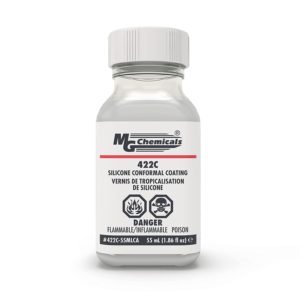
Oxidation is Our Enemy
There are two kinds of radio orienteering equipment: that which is experiencing electro-mechanical problems; and that which will experience electro-mechanical problems. You know the symptoms: volume controls sound scratchy, frequency controls cause unpredictable jumps, earphones sometimes don’t provide sound, and buttons and switches need to be jiggled before they will operate. Your previously reliable transmitter or receiver can no longer be counted on to function. Disaster! But there is a way to avoid most of those problems.
The Cause
Electro-mechanical parts will suffer whenever electronic equipment is placed in humid or dusty conditions. Electro-mechanical parts include buttons, switches, potentiometers, adjustable capacitors, jacks, and plugs. Pretty much anything that moves and contains mechanical wipers or contacts belongs in the electro-mechanical category.
Electro-mechanical components that are not hermetically sealed are vulnerable to the effects of humidity and dust. That’s because those devices rely on their surfaces remaining clean and electrically conductive. Oxidation occurs when these surfaces are exposed to the air, especially moist air. Impurities collect on surfaces when the air surrounding them contains dust or aerosols, and air always contains some level of moisture and dust. Oxidation and impurities are poor conductors of electricity and will eventually result in intermittent contact between otherwise-conductive surfaces.
Keeping your equipment clean, and storing it in a dry and clean location, will delay the onset of problems. But, eventually, the day will come when problems arise. Fortunately, there is usually a cure.
The Solution
Contact cleaners can save the day. Contact cleaners are available in spray cans or liquid dispensers sporting small nozzles or applicator brushes. Just about any contact cleaner product that advertises itself as safe for electronics and plastics will effectively remove oxidation and contaminants from electro-mechanical components and thereby restore them to normal operation. It is just a matter of figuring out how to get the cleaner to the surfaces needing cleaning. Sometimes that is easily accomplished, but some components prevent access to their innards where those surfaces are located. Applying generous amounts of contact cleaner to the outside of an electro-mechanical component while operating it will usually result in the contact cleaner working its way into the component and reaching the surfaces needing a good cleaning.
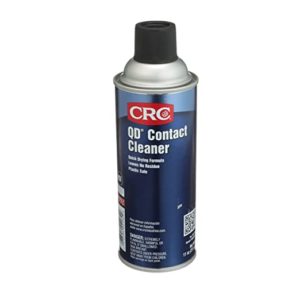
Some contact cleaners are “no residue.” After application, they dry completely, leaving nothing behind. No-residue cleaners perform their cleaning action only while they are in contact with a surface, helping to dissolve and remove contaminants where surfaces rub against each other, and then they are gone. No-residue cleaners are good for cleaning plugs and exterior surfaces where you don’t want to have anything that might get on your hands.
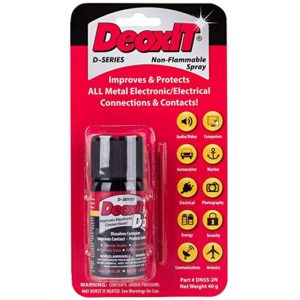
Other contact cleaners leave behind a protective film. These products are sometimes called “lubricating.” After their solvents have dispersed, a thin protective layer remains that lubricates and helps delay oxidation’s return. Lubricating contact cleaners are well-suited for equipment that will spend part of its life outdoors or in moist conditions.
Both no-residue and lubricating contact cleaners can be applied preventatively before problems occur. The periodic application will help avoid unexpected equipment problems. Despite being safe for plastic, both types of products contain solvents that might dissolve paints, dies, and ink. So avoid getting them on any vulnerable markings you have applied to your equipment.
GPS Device Approved for Orienteering
Garmin’s Enduro ultraperformance multisport watch has become the first GPS-enabled watch authorized by Adventure Race.
An Adventure Race is a multisport orienteering competition held on extremely rigorous terrain. When a user sets the watch for the Adventure Racing activity, location information is recorded but unavailable for racers to view during the event. Because Adventure Racing and orienteering competitions do not allow GPS navigation, users are not able to view GPS-based data fields, but they can still record a log of their track.
With Garmin Enduro, competitors can monitor and record biometric data like heart rate and will be able to use other functions of the watch like altimeter, compass, alarms, and timers. A verification page shows when the activity began and ended, allowing competitors to prove to an official that GPS navigation was disabled during the race.
Perhaps this will be a trend among device manufacturers, allowing the sport of ARDF to permit the Enduro and similar devices without violating ARDF’s requirement for competitors to rely only on their personal map-and-compass navigation skills.
Ranking Part 3: Ranking Criteria
Part one of this series of blog entries presented one reasonable approach to scoring ARDF competitions. Part two described a way to adjust competitor scores to make them apple-to-apple comparable from one event to the next. Part three examines how the adjusted scores might be brought together to provide a meaningful ranking system for USA ARDF athletes.
The goal of creating a ranking system is to display competitors’ names by order of their overall ARDF performance over some period of time. That is, their names should be ordered 1st, 2nd, 3rd, etc. based on how well they performed in recent ARDF competitions. Certain standards and criteria need to be applied in order to determine who gets ranked, and how their rank is determined. This post examines what some of those standards and criteria might be. It is not meant to impose any particular set of standards, but rather to present one approach that can serve as a starting point for discussion.
A competitor’s rank is just one criterion that might be used when selecting team members. Being highly ranked does not guarantee that a competitor will receive an invitation to join the team. Conversely, not being listed among the rankings does not mean that an individual won’t be selected for team membership. The team selection subcommittee is free to utilize all reasonable criteria to ensure that the team selection process is fair and equitable. Rankings are just one tool they may use to assist with the team selection process.
Who To Rank
A ranking system should not attempt to include every individual who has ever played the sport. It is fitting that only those who have demonstrated a certain mastery of the sport be included in the rankings. So the proposed system selects those individuals who meet the basic requirements.
Since the rankings are for USA competitors, it seems fitting that only those who might qualify for USA team membership be included. The USA ARDF Rules currently describe the basic requirements as follows:
Competitors eligible for USA ARDF Champion shall be citizens of the USA, Green Card holders, or have lived in the USA for the previous year and shall not have competed for the title of Champion in any other country.
USA RULES FOR AMATEUR RADIO DIRECTION FINDING Version 9-Feb-2020
Recent competitive ARDF experience is also an important criterion. Having met the basic requirements for team membership, ranked competitors also need to have competed in at least one recent ARRL-sanctioned ARDF event, and to have demonstrated a minimum level of mastery of the sport.
A suggested definition for a recent competition is an ARRL-sanctioned ARDF competition held during the two most recent calendar years in which ARRL-sanctioned events were held. Usually, that will be competitions held during the current year and the previous year. But COVID-19 demonstrated that there might be years in which no ARRL-sanctioned ARDF events are held.
As a minimum level of ARDF mastery, the suggested measure is this: in at least one recent sanctioned competition the competitor must have successfully located all assigned transmitters and registered at the finish before the time limit expired. In other words, they successfully completed at least one course. One might ask, “Why not rank everyone who didn’t OT?” There are two main reasons why assigning a rank to an individual should require a higher minimum standard: 1) It gives greater significance to the achievement of attaining ranked status, and 2) It may not be feasible to calculate an accurate rank for all who participated.
Expanding on the second point: consider that in a 5-transmitter M21 Classic competition a 5-fox minimum requirement results in just one possible combination of foxes and only one permutation that must be selected as the optimum order. But for those who find only four out of five foxes, there are five different combinations of foxes that must be analyzed to identify the one permutation that is the optimum order. If three out of five foxes are found then there are ten different fox combinations and ten more optimum permutations that must be analyzed. For two out of five foxes there are again ten combinations and permutations to be analyzed. And if only one fox is found there are five combinations. That means that there is potentially 5 + 10 + 10 + 5 = 30 times as much ranking analysis required if “not going OT” is used as a minimum ranking requirement in a five-fox competition. And that is just for the M21 category. When there are few competitors this will be a manageable problem, but clearly, setting too low a bar does not allow the ranking system to scale.
Remember that being ranked is not a prerequisite for being selected for Team USA. So not being ranked need not exclude any qualified individual from making the team. The Team Selection Subcommittee has latitude to take into account other factors, including extenuating circumstances when extending invitations for team membership. So, as a practical matter, restricting the number of those ranked, and having the team-selection process consider unranked individuals using a non-analytical methodology is the most reasonable approach.
Calculating Rankings
A competitor who meets all the criteria described above will have their rank calculated and listed in the rankings tables. Separate rankings will be calculated for each competition format: Classic 80m, Classic 2m, Sprint, and Foxoring. Within each format rankings table, the competitors will be ranked separately by age/gender category.
All qualifying competitors are eligible to receive up to four separate rankings: one for each competition format. Those rankings will be made relative to all other qualifying competitors in their age/gender category.
A competitor’s adjusted competition scores (see Part 2) will be used for determining rank. Only the highest event score achieved during a calendar year will be considered. (This will ensure there is no disincentive to participate in multiple events annually.) The highest score from both recent years will be averaged to determine a competitor’s ranking score. If the competitor only participated during one recent calendar year, then that year’s highest score will be the competitor’s ranking score. A competitor with a higher ranking score will be ranked above any competitor with a lower ranking score. Tied competitors will both receive the same rank, with the next lower rank(s) left vacant.
If a competitor lacks results from recent competitions because he/she helped conduct a sanctioned event, then their rankings will be calculated using the two most recent years for which they have qualifying results, going back up to four years.
Discussion
No ranking system is perfect. The one described above is no exception. But it does have simplicity working in its favor. The formulae it uses are simple, provably stable, and give predictable results. The entire system can be written in a short Javascript program and rendered on any browser. The results, and the source code, can be shared freely so that competitors and organizers can analyze it and improve upon it.
Ranking Part 2: Adjusting for Difficulty
ARDF is conducted in nature. So, like golf, mountain bike racing, or skiing, the venue influences the game’s difficulty level. Navigating in a sparse forest is easier than in jungle-like undergrowth. Running on flat smooth terrain doesn’t require as much effort as climbing steep rocky hills. Some ARDF courses are going to be more difficult than others, and that will always be the case.
So when a competitor scores highly on a difficult course it says more about his/her fitness and skills than acing an easier course. And because an ARDF score is derived from one’s finish time relative to other competitors on the course, prevailing against stiff competition is also a better indicator of an athlete’s skills and fitness level.
Venues across the USA have diverse terrains, and course difficulty can vary widely. So if we are going to compare scores achieved in competitions held at different venues those scores need to be adjusted accordingly. Ideally, the scoring system would be designed to handle adjustments automatically. In orienteering this is accomplished by calculating scores relative to the average times of the top finishers. Because orienteering competitions consistently have a sufficient number of highly-skilled entrants, the top performances establish a good baseline by which to compare the subordinate finishers.
But many ARDF categories at USA events lack highly-competitive entrants and sometimes contain only a single competitor. So the question arises: how to adjust ARDF scores to make them comparable from one event to the next?
Ideal Time
One proposal is to utilize the concept of ideal time (![]() ). Ideal time is the expected finish time for an elite ARDF athlete traversing a course with the following results:
). Ideal time is the expected finish time for an elite ARDF athlete traversing a course with the following results:
- Finds each assigned transmitter in optimum order following the shortest practical route based on the competition map;
- Unaffected by chance. E.g., doesn’t find any flags off-cycle, makes no wrong turns, etc.;
- Runs at a speed that is realistic for his/her age and gender category taking into account the running conditions present along the route followed.
Note that ideal time is not YOUR ideal time, nor is it the ideal time of any of the competitors in the competition. Ideal time represents what a healthy elite athlete should be able to accomplish without anything unpredictable happening.
There isn’t currently a software program capable of calculating ideal time, so it is a manual process. Although it is a manual process, it is not very difficult, and the process can be documented in detail in order to allow almost anyone to perform the calculation. Calculating ideal time involves spending some time analyzing the competition map, plotting the shortest practical route from start to finish along the optimum order of transmitters, and estimating a realistic speed of movement along that route. A unique ideal time is assigned for each course for each competition held during an ARDF event.
Once calculated, the ideal times represent the results that an elite athlete in each age/gender category could have achieved. Ideal time can be applied to the scoring approach presented in Part 1. By doing so, the scores of all competitors who found all the assigned transmitters will be adjusted, making them more reflective of what they would have scored had an elite athlete actually participated.
Adjusting for Competition
Calculating ideal time and inserting it into the race results has the effect of adjusting all competitors’ scores to reflect what they would have been had an elite competitor actually participated. This will be the case even for categories in which only a single competitor participated. Utilizing ideal time in this manner doesn’t require any special formulas, and the adjusted scores still reflect the correct finish order.
Examples
Consider the M40 results from a Classic 80m competition in which the ideal time was calculated to be 60 minutes (3600 seconds)and there were five transmitters for the M40 competitors to find.
(Example 1) M40 competitor “A” found all five transmitters and finished with a time of 75 minutes (4500 seconds). He had the best overall time (i.e., ![]() ) amongst all M40 competitors who found all five transmitters. Without putting ideal time into the results, competitor “A” would have a score of:
) amongst all M40 competitors who found all five transmitters. Without putting ideal time into the results, competitor “A” would have a score of:
![]() points
points
Including ideal time (![]() ) in the results adjusts the score of competitor “A” as follows:
) in the results adjusts the score of competitor “A” as follows:
![]() points
points
(Example 2) M40 competitor “B” who found only four of the five assigned transmitters. No adjustment for ideal time would be calculated for this competitor. Ideal time is only calculated for a course that includes all the assigned transmitters. Those who find fewer transmitters will not receive adjusted scores.
(Example 3) Let’s look at a very slow M40 competitor “C” who found all five transmitters but required the full time limit of 3 hours (10800 seconds). His unadjusted score would be:
![]() points
points
Adjusting for ideal time gives:
![]() points
points
Adjusting for Course Difficulty
The value calculated for ideal time will be greater for difficult courses and lesser for easier courses. Therefore, by comparing the ideal time calculated for an actual course with the ideal time calculated for a standard reference course, a unitless ratio can be derived. That ratio can be used to adjust competitor scores to account for the course’s difficulty.
So long as the standard reference is consistent the adjustment will be fair, since it will affect all competitors’ scores identically. So, for both consistency and simplicity, a reference of one hour is suggested for Classic and Foxoring courses, and fifteen minutes for Sprint, since those are the generally-used length targets used by most course designers. This reference can be named the ideal reference time ![]() and uses the same time units (seconds) as ideal time.
and uses the same time units (seconds) as ideal time.
The unitless ratio to be used for adjusting for course difficulty is calculated as follows:
(1) ![]()
Where:![]() is the unitless course difficulty factor,
is the unitless course difficulty factor,![]() is the ideal reference time, and
is the ideal reference time, and![]() is the ideal time.
is the ideal time.
The more difficult a course is the greater its ideal time. If the course designer made a course so that elite competitors complete it in the targeted amount of time (1 hour Classic/Foxoring or 15 minutes Sprint) then ![]() so that
so that ![]() . And as a course is made more difficult the value of
. And as a course is made more difficult the value of ![]() increases above
increases above ![]() , and less difficult courses will have
, and less difficult courses will have ![]() values less than
values less than ![]() .
.
![]() only applies to those factors affecting a competitor’s overall time. Therefore, only the time component of a competitor’s score should be multiplied by
only applies to those factors affecting a competitor’s overall time. Therefore, only the time component of a competitor’s score should be multiplied by ![]() .
. ![]() should not be applied to the component of a score derived from the number of transmitters found.
should not be applied to the component of a score derived from the number of transmitters found.
When ![]() is multiplied by the time component of a competitor’s course score adjusted for the ideal time, the result is the adjusted score (
is multiplied by the time component of a competitor’s course score adjusted for the ideal time, the result is the adjusted score (![]() ) that can be compared apples-to-apples to any other adjusted score for the same type of competition and age/gender category. Since transmitter count is not involved in the computation of the adjusted score, it is fine to rescale the score without regard to the number of transmitters. So the formula for adjusted score is simply:
) that can be compared apples-to-apples to any other adjusted score for the same type of competition and age/gender category. Since transmitter count is not involved in the computation of the adjusted score, it is fine to rescale the score without regard to the number of transmitters. So the formula for adjusted score is simply:
(2) ![]()
Where:![]() is the adjusted score for competitor
is the adjusted score for competitor ![]() ,
,![]() is the course difficulty factor,
is the course difficulty factor,![]() is the ideal time for the course, and
is the ideal time for the course, and![]() is the finish time for competitor
is the finish time for competitor ![]() .
.
Inserting the right side of Equation 1 for ![]() into Equation 2 gives the following equation for
into Equation 2 gives the following equation for ![]() that allows us to skip the calculation of
that allows us to skip the calculation of ![]() :
:
(3) ![]()
Where:![]() is the adjusted score for competitor
is the adjusted score for competitor ![]() ,
,![]() is the ideal time for the course,
is the ideal time for the course,![]() is the ideal reference time,
is the ideal reference time,![]() is the finish time for competitor
is the finish time for competitor ![]() .
.
Example
(Example 4) Consider the M40 results from a Classic 80m competition in which the ideal time (![]() ) was calculated to be 60 minutes (3600 seconds).
) was calculated to be 60 minutes (3600 seconds).
With the information above, calculate the adjusted score (![]() ) for Example 1. First, select the appropriate ideal reference time:
) for Example 1. First, select the appropriate ideal reference time:
![]() seconds (For a Classic competition.)
seconds (For a Classic competition.)
Use ![]() ,
, ![]() , and
, and ![]() to calculate the adjusted score for competitor “A” from Example 1. Using Equation 3:
to calculate the adjusted score for competitor “A” from Example 1. Using Equation 3:
![]()
![]() 80.0 points
80.0 points
Other Comments
Because ideal time assumes no chance events, it is possible that some elite competitors will achieve finish times shorter than ideal time. When that happens in the scoring system described in Part 1, those athletes will receive scores greater than 100.0 after the ideal time is applied to the overall results. Such outcomes are acceptable and should be interpreted as indicating that some transmitters were probably found off-cycle.
The scoring methodology described in these posts does not attempt to adjust for differences between the various competition formats, competitor age, or gender. Therefore, adjusted scores must only be compared or combined with other adjusted scores for the same competition format and age/gender category.
There have been some questions regarding Equation 3 and its use of the square of ideal time (![]() ). The ideal time is squared in the calculation of adjusted score (
). The ideal time is squared in the calculation of adjusted score (![]() ) because it is being used to compensate for two separate and independent factors: the strength of the competition, and course difficulty. So it is necessary for it to be applied twice.
) because it is being used to compensate for two separate and independent factors: the strength of the competition, and course difficulty. So it is necessary for it to be applied twice.
Note that the adjusted score contains only a time component and therefore isn’t affected by transmitter count. The effects of transmitter count were accounted for in the calculation of ideal time and adjusted score. So it is reasonable to combine (e.g., average) and compare adjusted scores within the same age/gender category from competitions of the same format having differing numbers of transmitters.
Experimentation with the formulae above is encouraged. Their use over time will no doubt reveal improvements to this scoring approach.
Summary
Because ideal time assumes the technical skills and fitness level of an elite athlete, it can be used to adjust for the absence of strong competition at a particular event. Because ideal time takes into account the actual course lengths and terrain, it can be used to adjust for the effects of the venue on competitor scores. Because the process of calculating ideal time can be documented and repeated by trained individuals, it can be applied objectively and precisely.
But, ideal time is not an ideal solution. It would be better to have a sufficient number of elite competitors at each ARDF competition to utilize orienteering’s scoring approach. But until the day of highly-competitive USA ARDF contests arrives, the use of ideal time as presented above is a reasonable approach allowing results to be compared between events having different levels of difficulty, even when few (or no) elite competitors were in attendance.
The approach described in this writing will not impact the order of finish for any event, but it achieves two important goals:
- It allows competitors to see how they would have scored relative to elite competitors like those they might find at a World Championships.
- It provides a way to fairly compare scores from events held at different venues and presenting different levels of difficulty.
Number 2 above will be examined more closely in Part 3.
Ranking Part 1: Scores for ARDF
Among other duties, the ARRL ARDF Committee is tasked with establishing a fair and equitable ranking system for use in team selection. It has been rightly pointed out that there are many considerations when selecting a team. Some considerations deal with subjective factors that have little or nothing to do with how well a candidate performed historically at ARDF events.
But competitive performance is one useful and objective factor that can be readily quantified and analyzed. And so competitive performance at ARRL-sanctioned ARDF events should be calculated and utilized as one component of a fair team selection process. It will also be helpful to competitors wanting to track their performance relative to their competition.
ARDF rules stipulate that the place (1st, 2nd, 3rd, etc.) of an individual competitor depends firstly on the number of transmitters found, and secondly on his or her running time. The rules provide no numerical formulae for deriving a single number to represent a competitor’s performance. But such a number would be helpful for facilitating a mathematically-rigorous ranking system, and would be the first of three steps to establishing such a system:
- Establish a scoring system for ARDF competitions.
- Define an approach for adjusting competition scores to make them comparable between courses with different difficulty levels.
- Create a formula for combining adjusted scores to obtain a competitor’s rank relative to other competitors in his or her age/gender category.
The subject at hand is the first bullet above: how to represent a competitor’s ARDF performance at a single competition as a single numerical score. The other two bullets will be addressed in later postings.
Scores for ARDF
ARDF rules require that both the number of transmitters found, and the amount of time a competitor takes to reach the finish line, be used to determine a competitor’s place. And since a competitor’s score should accurately reflect their placement relative to other competitors, the score calculation must also utilize both the number of transmitters found, and a competitor’s total time, to derive their score.
Since the rules require the total transmitters found to be decisive in a competitor’s placement, time must never contribute more to a competitor’s score than does a single transmitter. In other words, no matter how fast a competitor runs a course, his/her score for that race must be less than the score of any competitor who found more transmitters. The rules demand it.
Most other properties of a score may be chosen arbitrarily. For instance, whether a score is proportional or inversely proportional to a competitor’s placement is totally a matter of convention. So, to keep things simple, the following scoring conventions will be used here:
- A higher score reflects a higher (better) placement with a score of 100.0 being awarded to the first-place finisher(s) of an age/gender category.
- All transmitters count the same amount toward the calculation of a competitor’s score.
- Competitors’ times are scored relative to the fastest time of any competitor who found the same number of transmitters.
Item 3 is worthy of additional discussion. Note that all competitors within an age/gender category are always assigned the exact same course to run, and therefore the same number of transmitters to find. But the rules allow any competitor to choose, at their own discretion, to find only a subset of the assigned transmitters. A competitor might elect to find fewer transmitters if, for instance, finding more transmitters seems likely to result in their being classified Overtime (OVT). By choosing to find fewer than the assigned number of transmitters a competitor can avoid being classified OVT. But by choosing to find fewer transmitters a competitor accepts a placement below all the competitors who find more of the assigned transmitters than they. So, in effect, by choosing to find fewer transmitters they place themselves in a separate category of finisher. Since the rules effectively segregate finishers’ placements by the number of transmitters found, it is appropriate then that their times be likewise segregated and compared only to the times of others in their category who elected to find the same number of transmitters.
Score Calculations
Since all transmitters count the same toward a competitor’s score, and a competitor’s speed performance (time) must count no more than a single transmitter, each transmitter and the time component of the score is assigned a maximum score value of:
(1) ![]()
Where ![]() is the point value of each transmitter found (and maximum points awarded based on finish time),
is the point value of each transmitter found (and maximum points awarded based on finish time), ![]() is the total number of transmitters assigned to a competitor.
is the total number of transmitters assigned to a competitor.
So, for example, if an M40 competitor is assigned five transmitters to locate, then each of the transmitters will have a score value of ![]() or
or ![]() points. The maximum number of points the M40 competitor can gain by having the fastest overall time among all M40 competitors on that course is also
points. The maximum number of points the M40 competitor can gain by having the fastest overall time among all M40 competitors on that course is also ![]() points. So the total score for competitor “c” is given by:
points. So the total score for competitor “c” is given by:
(2) ![]()
Where ![]() is the score for competitor
is the score for competitor ![]() ,
,![]() is the total number of transmitters found by competitor
is the total number of transmitters found by competitor ![]() ,
,![]() is the overall time in seconds of the fastest of the competitors who found
is the overall time in seconds of the fastest of the competitors who found ![]() transmitters,
transmitters, ![]() is the competitor’s overall time in seconds, and
is the competitor’s overall time in seconds, and![]() is the value derived in equation (1)
is the value derived in equation (1)
Examples:
(Example 1) M40 competitor “A” is assigned to locate five transmitters and finds all five, and also has the best overall time (i.e., ![]() ) amongst all M40 competitors who found all five transmitters. He would have a score of:
) amongst all M40 competitors who found all five transmitters. He would have a score of:
![]() points
points
(Example 2) M40 competitor “B” who found only four transmitters, and who had the best overall time amongst all M40 competitors who found four of the transmitters would have a score of:
![]() points
points
(Example 3) Let’s look at a very slow M40 competitor “C” who found all five transmitters but required 10 times as long to reach the finish line as did the competitor in Example 1:
![]() points
points
Note in Example 3 that the slow finisher finding all five transmitters still received a score substantially higher than the best competitor who found only four transmitters in Example 2.
Other Observations
Note that equation (1) implies that the more transmitters assigned to competitors the smaller the effect of each individual transmitter and of time on the competitors’ scores. Consider: if there were only one transmitter to find, equation (1) says that finding the single transmitter would account for 50 points, and one’s finish time could account for up to an additional 50 points. But if we increase the number of transmitters to nine, then finding a single transmitter adds just 10 points to one’s score and time accounts for just 10 points as well. This can be difficult to reconcile when combining scores (e.g., for averaging, etc.) from competitions in which different numbers of transmitters were assigned.
To avoid the pitfalls of mixing or comparing scores derived from differing time and transmitter component values, the following approach is suggested:
- Only scores for the same competition format will be combined or compared.
- Only scores for competitors finding the same number of transmitters on the same course in the same age/gender category will be combined or compared.
Limitations of Scoring
The above approach for deriving a single score for competitors’ ARDF race results can be helpful for comparing performance among those competing within the same age/gender category and on the same course. But it would fall short if it were used to compare performances on courses of significantly different levels of difficulty. That subject will be addressed in Part 2.
GPS White Paper
Several years ago the IARU Region 1 ARDF Working Group added a rule (T4.2) that permits the use of GPS devices lacking map displays. Some have assumed that there is no navigation assistance possible without a digital map. Those folks assumed that T4.2 effectively banned all GPS navigation assistance during a competition. Those persons were mistaken. There is considerable navigation support that GPS can provide to ARDFers even if no map is presented. Some have begun utilizing those GPS navigational aids in international competition.
Having been an EE who worked with GPS as part of my job and hobbies, and having created several GPS-related App Store apps for smartphones, I believe that I can speak with some authority on the capabilities of GPS and the assistance it can provide. To encourage informed discussion on the subject I have written a white paper. It is available at no cost and may be shared freely by all. The pdf can be downloaded here.
No national ARDF team wants to put itself at a disadvantage. Since GPS assistance is currently allowed under the rules applied to most ARDF World Championships (WC) there is strong pressure for the same assistance to be permitted at competitions used to determine national teams. Not doing so could prevent a team from being adequately equipped to compete against other teams that are fully utilizing GPS capabilities. Because of the gravitational tug to conform to WC rules, all national teams are affected by the decisions made by the dominant regional organizations. Therefore, all national organizations should represent their points of view on the subject to IARU regional ARDF rules makers.
This thread is not for debating GPS issues. The facts are laid out in the white paper. Those who disagree with the facts or recommendations in the attached document should write their own white paper, or contact me directly with their concerns.
73,
Charles E. Scharlau – NZ0I
nz0i@openardf.org

